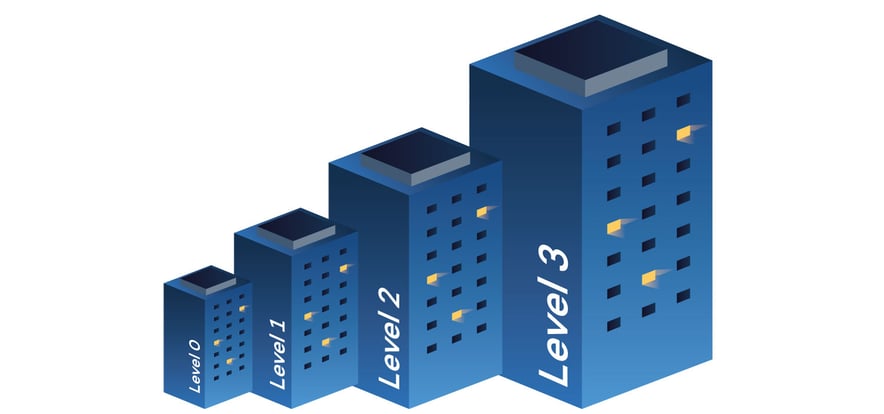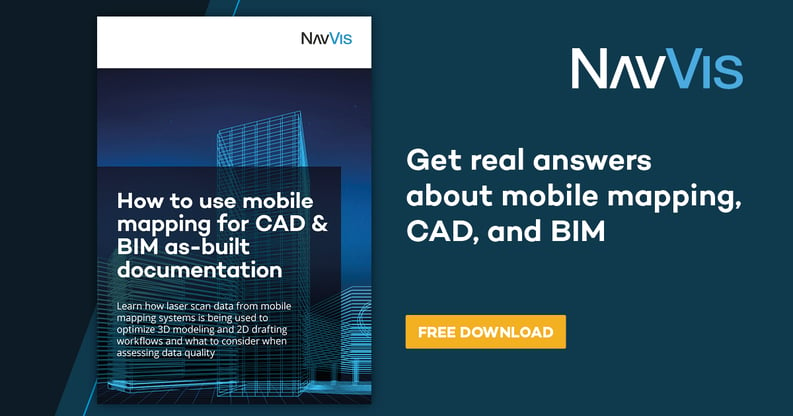What is the future of BIM? To make projections about the future of BIM, let’s extrapolate from the status of BIM in the present day.
In previous articles about Building Information Modeling (BIM), we've covered topics like everything you need to know about scan-to-BIM, 12 steps to bring an existing building into BIM, and the 5 biggest challenges to updating BIM models (and how to overcome them). Next, let’s talk about BIM in current and future practice.
BIM today is a single-source-of-truth design methodology that enables specialists from every stage of a construction project to collaborate on the same set of data. Whether they are architecture, engineering, or construction (AEC) professionals, individuals can contribute using tools that are specific to their industry while still coordinating their activities with other stakeholders.
The shift towards BIM is momentous for the AEC industry, with consequences for the built environment which are dynamic and profound – but it didn’t happen overnight. As a design philosophy, BIM has been around since the 1970s. And in that time, there has been a steady consolidation of tools, processes, and shared understanding.
So, what will BIM look like in the future? Will it continue to evolve and develop? Or will it be superseded by something else? To make projections about the future of BIM, let’s extrapolate from the landscape of BIM in the present day.
BIM adoption as an industry standard is inevitable
BIM models are becoming the norm not just in new buildings, but also in the refurbishment and renovation of existing structures. Scan-to-BIM plays a significant role here, where laser scanning technology creates point clouds that feed into the development of a BIM model for a pre-existing building.
The primary outcome improvements delivered by BIM are substantial, making a positive impact on overall efficiency, budget, and project coordination. According to the 2020 NBS BIM Survey, 72% of BIM adopters (and 64% of those yet to adopt BIM) say that BIM reduces the risk of problems on projects, so there are fewer knock-on effects like time delays, cost overruns or disputes.
There are many national institutions to guide the implementation of BIM. These include the National BIM Standard (USA), the BSi Standard Framework and Guide to BS1192 (UK), Rgd BIM (Netherlands), and Stufenplan Digitales Planen und Bauen (Germany). They are in alignment on a global level, while also considering regional context and ways of working.
Meanwhile, countries like the United Kingdom, Germany, Spain, and Australia already have government mandates for obligatory use of BIM in public sector infrastructure projects. Others are following suit. For these reasons, the adoption of BIM as an overarching standard in the AEC industry is practically inevitable.
The strategic roadmap for BIM

The strategic roadmap for the BIM industry has four levels. Each level represents the extent of collaboration and the application of digitization to a construction or infrastructure project.
- BIM Level 0 denotes a complete absence of collaboration between stakeholders, and projects will only use 2D computer-aided design (CAD) drafting. Distribution is either paper-based or electronic (or a mixture of both). This BIM level is pretty much obsolete today.
- BIM Level 1 represents partial collaboration between multiple stakeholders and disciplines. Projects at this level use a mixture of 2D and 3D CAD drafting. Information is shared digitally using a common data environment (CDE), managed by the principal contractor and shared among team members, and projects may also use some standard data structures and formats.
- BIM Level 2 projects are fully collaborative, with stakeholders using intelligent, data-rich 3D objects in a sophisticated BIM environment. In this instance, all parties working on a project can combine their BIM and design data to work together and share information through a CDE. The CDE enables users to carry out regular checks against data validation strategies to ensure the project stays on track.
- One indicator of maturity for BIM Level 2 projects is the inclusion of a fourth dimension as represented by time, which enables planning of construction sequences.
- Another is a fifth dimension of cost information for improved cost management.
- BIM Level 3 denotes full collaboration and full integration among all disciplines and stakeholders. They’re using a single, shared project view for data integration, which all parties can access and modify as defined through process and security controls.
- Projects at this level can also have dedicated project streams that inform facility management (FM). In effect, a six-dimensional model which enables improved asset management for the complete lifecycle of a building.
The UK had officially mandated BIM Level 2 in 2016 and is working out a path towards Level 3. In Germany, progress has not been as quick. BIM will be made mandatory for all infrastructure projects by the end of 2020. Beyond that, there are no requirements for the use of BIM.
What happens if you don’t embrace BIM?
All boats must rise with the tide: AEC companies that don’t adopt BIM may fall foul of incoming legislation or, worse, go out of business.
Looking at other industries, for example, photography or telecommunications, something similar happened when leading companies failed to embrace digitization or moved too slowly. Once upon a time, Kodak and Nokia dominated their respective markets for film photography and mobile phones. That isn’t the case today.
Even without a regulatory push for BIM, working without it leaves your business vulnerable to silos of information that create drags on efficiency, cost, and coordination. Moreover, design teams (and others) who do not embrace the opportunities created by BIM will be left at a competitive disadvantage to those who do.
Nor is this idle speculation or hysteria. The disruptive impact of BIM will continue as new technologies emerge that take advantage of BIM data – e.g., additive manufacturing, virtual reality, and augmented reality – for better visualization or to support specific BIM workflows.
For example, BIM can allow digital files of 3D printable objects to be integrated into designs, evaluated, and then shifted over to rapid prototyping. BIM also empowers architects to guide clients and contractors through their designs using virtual reality before a single brick has been laid, or augmented reality goggles to compare progress against plans at the construction site.
There’s also the matter of big data. New technologies can provide additional sources of information, such as point clouds gathered by laser scanners. Conducting daily scans leads to a continually evolving dataset to organize and optimize management of the building, even after construction is complete.
Wrapping up
The future of BIM is already here; it’s not a wish list of prophecies and predictions, but a tangible reality in the present. Achievable targets at the national and international level have led to fully collaborative construction and infrastructure projects within the AEC industry, together with a roadmap for continued evolution and refinement.
Today it’s possible to address the complete lifecycle of a building, from design to construction, and from maintenance to renovation. From the perspective of the laser scanning practitioners and BIM specialists, it’s important to continue bringing 3D models together with reality capture technology enabled by point cloud processing advances, to more seamlessly connect these collaborative models with the physical realm.
Looking for some further reading? Download our complimentary resource on using mobile mapping for CAD and BIM as-built documentation.


